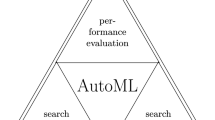Abstract
This article introduces the “CAM-Brain Machine” (CBM), an FPGA based piece of hardware which implements a genetic algorithm (GA) to evolve a cellular automata (CA) based neural network circuit module, of approximately 1,000 neurons, in about a second, i.e., a complete run of a GA, with 10,000s of circuit growths and performance evaluations. Up to 65,000 of these modules, each of which is evolved with a humanly specified function, can be downloaded into a large RAM space, and interconnected according to humanly specified artificial brain architectures. This RAM, containing an artificial brain with up to 75 million neurons, is then updated by the CBM at a rate of 130 billion CA cells per second. Such speeds should enable real time control of robots and hopefully the birth of a new research field that we call “brain building.” The first such artificial brain, to be built in 2000 and beyond, will be used to control the behaviors of a life sized robotkitten called “Robokitty.”
Similar content being viewed by others
References
de Garis, Hugo website. de Garis's journal articles already published, to be published, and submitted, can be viewed online from his website at http://foobar.starlab.net/~degaris/journal.html.
de Garis, Hugo. 1992. Genetic Programming: GenNets, Artificial Nervous Systems, Artificial Embryos. Ph.D. thesis, Brussels University. Available at http://foobar.starlab.net/~degaris.
de Garis, Hugo. 1994. An artificial brain: ATR's cam-brain project aims to build/evolve an artificial brain with a million neural net modules inside a trillion cell cellular automata machine. New Generation Computing Journal, 12(2).
de Garis Hugo, Buller Andrzej, Korkin Michael, Gers Felix, Nawa Norberto Eiji, and Hough, Michael. 1999. ATR's artificial brain (CAM-Brain) project: A sample of what individual CAM-Brain modules can do with digital and analog I/O. In Proceedings of the First NASA/DoD Workshop on Evolvable Hardware, july 19–21, Pasadena, California, IEEE Computer Society, ISBN 0–7695–0256–3.
de Garis Hugo, Gers Felix, Korkin Michael, Agah Arvin, and Eiji Nawa Norberto. 1998. Building an artificial brain using an FPGA based ‘CAM-brain machine’. Artificial Life and Robotics Journal, 2:56–61.
de Garis Hugo, Petroff Nikolai, Korkin Michael, and Fehr Gary. Simulation and evolution of the motions of a life sized kitten robot ‘robokitty’ to be controlled by a 32000 neural net module artificial brain. Submitted for publication, available on website http://foobar.starlab.net/~degaris/papers/ JCG.html.
Genobyte, Inc., based in Boulder, Colorado, at URL http://www.genobyte.com.
Gers Felix, de Garis Hugo, and Korkin Michael. 1997. Codi-1 Bit: A simplified cellular automata based neuron model. In Proceedings of AE97, Artificial Evolution Conference.
David, E. Goldberg. 1989. Genetic Algorithms in Search, Optimization, and Machine Learning, Addison-Wesley: Reading, MA.
Higuchi T., Iwata, M., and Liu, W. (Eds.) 1997. Evolvable Systems: from Biology to Hardware. Lecture Notes in Computer Science No 1259, Springer-verlog: Berlin.
Korkin Michael, de Garis Hugo, Gers Felix, and Hemmi Hitoshi. 1997. CBM (CAM-Brain Machine): A hardware tool which evolves a neural net module in a fraction of a second and runs a million neuron artificial brain in real time. In Genetic Programming 1997: Proceedings of the Second Annual Conference, John R. Koza, Kalyanmoy Deb, Marco Dorigo, David B. Fogel, Max Garzon, Hitoshi Iba, and Rick L. Riolo (Eds.).
Korkin Michael, Eiji Nawa Norberto, and de Garis Hugo. 1998. A 'spike interval information coding’ representation for ATR's CAM-brain machine (CBM). In Proceedings of the Second International Conference on Evolvable Systems: From Biology to Hardware (ICES'98). Springer-Verlag: Berlin.
MSNBC. Sit, aibo, sit!, msnbc, technology report. Available on website http://www.msnbc.com/news/268649.asp.
Rieke Fred, Warland David, de Ruyter van Steveninck Rob, and Bialek William. 1997. Spikes: Exploring the Neural Code. MIT Press/Bradford Books: Cambridge, MA.
Rumelhart David and L. McClelland James. 1986. Parallel Distributed Processing: Explorations in the Microstructure of Cognition. MIT Press/Bradford Books: Cambridge, MA.
Sanchez Eduardo and Tomassini Marco (Eds.) 1996. Towards Evolvable Hardware: The Evolutionary Engineering Approach. Lecture Notes in Computer Science No 1062, Springer-Verlag: Berlin.
Thompson Adrian and Layzell Paul. 1999. Analysis of unconventional evolved electronics. Communications of the ACM, 42(4): 71–79.
Toffoli, T. and Margolus, N. 1987. Cellular Automata Machines, MIT Press: Cambridge, MA.
Xilinx, Inc. 1996. The Programmable Logic Data Book 1996.
Author information
Authors and Affiliations
Rights and permissions
About this article
Cite this article
de Garis, H., Korkin, M. & Fehr, G. The CAM-Brain Machine (CBM): An FPGA Based Tool for Evolving a 75 Million Neuron Artificial Brain to Control a Lifesized Kitten Robot. Autonomous Robots 10, 235–249 (2001). https://doi.org/10.1023/A:1011286308522
Issue Date:
DOI: https://doi.org/10.1023/A:1011286308522




